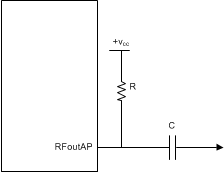SNAS736C June 2017 – April 2019 LMX2595
PRODUCTION DATA.
- 1 Features
- 2 Applications
- 3 Description
- 4 Revision History
- 5 Pin Configuration and Functions
- 6 Specifications
-
7 Detailed Description
- 7.1 Overview
- 7.2 Functional Block Diagram
- 7.3
Feature Description
- 7.3.1 Reference Oscillator Input
- 7.3.2 Reference Path
- 7.3.3 PLL Phase Detector and Charge Pump
- 7.3.4 N-Divider and Fractional Circuitry
- 7.3.5 MUXout Pin
- 7.3.6 VCO (Voltage-Controlled Oscillator)
- 7.3.7 Channel Divider
- 7.3.8 VCO Doubler
- 7.3.9 Output Buffer
- 7.3.10 Power-Down Modes
- 7.3.11 Phase Synchronization
- 7.3.12 Phase Adjust
- 7.3.13 Fine Adjustments for Phase Adjust and Phase SYNC
- 7.3.14 Ramping Function
- 7.3.15 SYSREF
- 7.3.16 SysRefReq Pin
- 7.4 Device Functional Modes
- 7.5 Programming
- 7.6
Register Maps
- 7.6.1 General Registers R0, R1, & R7
- 7.6.2 Input Path Registers
- 7.6.3 Charge Pump Registers (R13, R14)
- 7.6.4 VCO Calibration Registers
- 7.6.5 N Divider, MASH, and Output Registers
- 7.6.6 SYNC and SysRefReq Input Pin Register
- 7.6.7 Lock Detect Registers
- 7.6.8 MASH_RESET
- 7.6.9 SysREF Registers
- 7.6.10 CHANNEL Divider And VCO Doubler Registers
- 7.6.11 Ramping and Calibration Fields
- 7.6.12 Ramping Registers
- 7.6.13 Readback Registers
- 8 Application and Implementation
- 9 Power Supply Recommendations
- 10Layout
- 11Device and Documentation Support
- 12Mechanical, Packaging, and Orderable Information
8.1.4 RF Output Buffer Pullup
The choice of output buffer components is very important and can have a profound impact on the output power. Table 40 shows how to treat each pin. If using a single-ended output, a pullup is required, and the user can put a 50-Ω resistor after the capacitor.
Table 40. Different Methods for Pullup on Outputs
| PULLUP STYLE | DIAGRAM | COMMENTS |
|---|---|---|
| Inductor |  |
Potentially higher output power, but output impedance is far from 50 Ω. Consider also using with a resistive pad. |
| Resistor |  |
More consistent matching |
Table 41. Output Pullup Configuration
| COMPONENT | VALUE | PART NUMBER |
|---|---|---|
| Inductor | Varies with frequency | |
| Resistor | 50 Ω | Vishay FC0402E50R0BST1 |
| Capacitor | Varies with frequency | ATC 520L103KT16T
ATC 504L50R0FTNCFT |